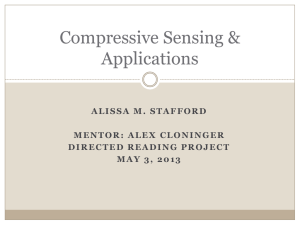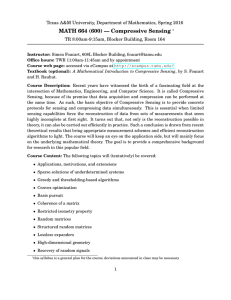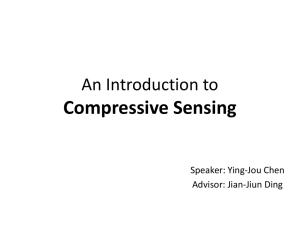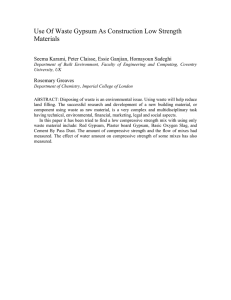IRJET- Reconstruction of Sparse Signals(Speech) Using Compressive Sensing
advertisement
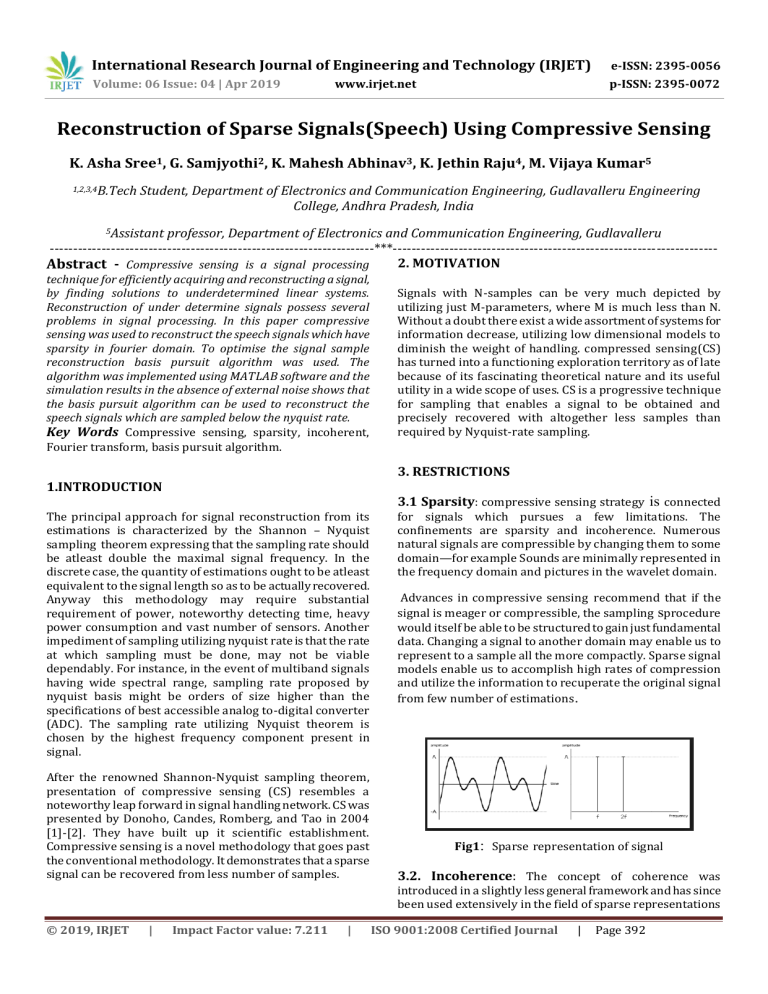
International Research Journal of Engineering and Technology (IRJET)
e-ISSN: 2395-0056
Volume: 06 Issue: 04 | Apr 2019
p-ISSN: 2395-0072
www.irjet.net
Reconstruction of Sparse Signals(Speech) Using Compressive Sensing
K. Asha Sree1, G. Samjyothi2, K. Mahesh Abhinav3, K. Jethin Raju4, M. Vijaya Kumar5
1,2,3,4B.Tech
Student, Department of Electronics and Communication Engineering, Gudlavalleru Engineering
College, Andhra Pradesh, India
5Assistant
professor, Department of Electronics and Communication Engineering, Gudlavalleru
---------------------------------------------------------------------***--------------------------------------------------------------------2. MOTIVATION
Abstract - Compressive sensing is a signal processing
technique for efficiently acquiring and reconstructing a signal,
by finding solutions to underdetermined linear systems.
Reconstruction of under determine signals possess several
problems in signal processing. In this paper compressive
sensing was used to reconstruct the speech signals which have
sparsity in fourier domain. To optimise the signal sample
reconstruction basis pursuit algorithm was used. The
algorithm was implemented using MATLAB software and the
simulation results in the absence of external noise shows that
the basis pursuit algorithm can be used to reconstruct the
speech signals which are sampled below the nyquist rate.
Key Words Compressive sensing, sparsity, incoherent,
Fourier transform, basis pursuit algorithm.
Signals with N-samples can be very much depicted by
utilizing just M-parameters, where M is much less than N.
Without a doubt there exist a wide assortment of systems for
information decrease, utilizing low dimensional models to
diminish the weight of handling. compressed sensing(CS)
has turned into a functioning exploration territory as of late
because of its fascinating theoretical nature and its useful
utility in a wide scope of uses. CS is a progressive technique
for sampling that enables a signal to be obtained and
precisely recovered with altogether less samples than
required by Nyquist-rate sampling.
3. RESTRICTIONS
1.INTRODUCTION
3.1 Sparsity: compressive sensing strategy is connected
The principal approach for signal reconstruction from its
estimations is characterized by the Shannon – Nyquist
sampling theorem expressing that the sampling rate should
be atleast double the maximal signal frequency. In the
discrete case, the quantity of estimations ought to be atleast
equivalent to the signal length so as to be actually recovered.
Anyway this methodology may require substantial
requirement of power, noteworthy detecting time, heavy
power consumption and vast number of sensors. Another
impediment of sampling utilizing nyquist rate is that the rate
at which sampling must be done, may not be viable
dependably. For instance, in the event of multiband signals
having wide spectral range, sampling rate proposed by
nyquist basis might be orders of size higher than the
specifications of best accessible analog to-digital converter
(ADC). The sampling rate utilizing Nyquist theorem is
chosen by the highest frequency component present in
signal.
After the renowned Shannon-Nyquist sampling theorem,
presentation of compressive sensing (CS) resembles a
noteworthy leap forward in signal handling network. CS was
presented by Donoho, Candes, Romberg, and Tao in 2004
[1]-[2]. They have built up it scientific establishment.
Compressive sensing is a novel methodology that goes past
the conventional methodology. It demonstrates that a sparse
signal can be recovered from less number of samples.
for signals which pursues a few limitations. The
confinements are sparsity and incoherence. Numerous
natural signals are compressible by changing them to some
domain—for example Sounds are minimally represented in
the frequency domain and pictures in the wavelet domain.
Advances in compressive sensing recommend that if the
signal is meager or compressible, the sampling sprocedure
would itself be able to be structured to gain just fundamental
data. Changing a signal to another domain may enable us to
represent to a sample all the more compactly. Sparse signal
models enable us to accomplish high rates of compression
and utilize the information to recuperate the original signal
from few number of estimations.
Fig1: Sparse representation of signal
3.2. Incoherence: The concept of coherence was
introduced in a slightly less general framework and has since
been used extensively in the field of sparse representations
© 2019, IRJET
|
Impact Factor value: 7.211
|
ISO 9001:2008 Certified Journal
|
Page 392
International Research Journal of Engineering and Technology (IRJET)
e-ISSN: 2395-0056
Volume: 06 Issue: 04 | Apr 2019
p-ISSN: 2395-0072
www.irjet.net
of signals. In particular, it is used as a measure of the ability
of suboptimal algorithms such as matching pursuit and basis
pursuit to correctly identify the true representation of a
sparse signal. To be formal, one defines the coherence or the
mutual coherence of a matrix A is defined as the maximum
absolute value of the cross-correlations between the
columns of A. Formally, let a1,a2,…..aN be the columns of the
matrix A, which are assumed to be normalized such that
aaT=1. The mutual coherence of A is then defined as μ(A).
μ(A) =
i
T
aj|
(1)
We say that a dictionary is incoherent if μ(A) is small.
Standard results then require that the measurement matrix
satisfy a strict incoherence property. Coherence is in some
sense a natural property in the compressed sensing
framework, for if two columns are closely correlated, it will
be impossible in general to distinguish whether the energy
in the signal comes from one or the other.
Fig 2: Signal in different domains
The CS acquisition model can be described mathematically
by
y=
(5)
where y is the compressed signal of length m, is
Gaussian random matrix and x is the input signal
represented in transformed domain shown in eq (1). The
compressed signal is recovered back by using only m
samples.
4. FOURIER TRANSFORM
6. RECONSTRUCTION OF COMPRESSED SIGNAL
Discrete Fourier Transform (DFT) is a fundamental
transform in digital signal processing with applications in
frequency analysis, signal processing etc. DFT is the
transformation of the discrete signal taking in time domain
into its discrete frequency domain representation. The
periodicity and symmetry properties of DFT are useful for
compression. The nth DFT coefficient of length N sequence
x(n) is defined as follows:
X(k)=
e-2πjnk/N ;k=0,1..,N-1
(2)
And its inverse transform(IDFT) as:
x(n)=
e2πjnk/N,n=0,1..,N-1.
(3)
The inputs to the reconstruction algorithm are the
measurement vector y and reconstruction matrix Φ and
The number of complex multiplications and additions to
compute DFT is N2. Moreover fast algorithms exist that
makes it possible to compute DFT efficiently. This algorithm
is popularly known as Fast Fourier Transform (FFT) which
reduces the computational burden to Nlog2N. FFT is
computational efficient algorithms to compute the DFT and
its inverse.
5. GENERATION OF COMPRESSED SIGNAL
Consider a real-valued, finite length, one-dimensional,
discrete-time signal x, which can be viewed as an N ×1
column vector in RN with elements x[n], n = 1, 2,….., N . The
image or higher-dimensional data can be treated by
vectorizing it into a long one dimensional vector. For
simplicity, assume that the basis is orthonormal. we can
express any signal x as:
x=
(4)
iΨi or x=Ψs
where s is the N ×1 column vector, x and s are equivalent
representations of the same signal, with x in the time domain
and s in the Ψ domain. We will focus on signals that have a
sparse representation which is fourier transform domain
here.
© 2019, IRJET
|
Impact Factor value: 7.211
|
y= ΦΨs = Θs
(6)
Fig 3: Representation of equation (6)
Where Θ = ΦΨ is an M × N matrix. The measurement
process is non-adaptive; that is, Φ does not depend in any
way on the signal x.
The original signal can be recovered back from compressive
measurements which is an underdetermined system of
linear equations and have infinite number of possible
solutions. In such cases, the unique solution can be obtained
by posing the reconstruction problem as an l0-optimization
problem .The l0-optimization problem searches for a solution
having minimum l0-norm subject to the given constraints.
This is equivalent to trying all the possibilities to and the
desired solution.
Ŝ=arg
(7)
1
where ||s||1 denotes the l1-norm of s, which represents the
absolute sum of elements of a vector. The generalized
expression of a norm is given by (8), from which definition of
l1 and other relevant norms can be obtained wherever
required.
p
lp: ||x||p =
(8)
ISO 9001:2008 Certified Journal
|
Page 393
International Research Journal of Engineering and Technology (IRJET)
e-ISSN: 2395-0056
Volume: 06 Issue: 04 | Apr 2019
p-ISSN: 2395-0072
www.irjet.net
Inorder to reconstruct the signal an algorithm should be
required. In this context basis pursuit algorithm is used.
7. BASIS PURSUIT ALGORITHM
In the above signal, significant information is mainly
concentrated in frequency ranges between 3500 Hz to10600
Hz. Hence considering the signal within the range the above
signal will shown in Fig 5.
Basis Pursuit (BP) is a convex optimization problem, which
searches for a solution having minimum l1-norm, subject to
the equality constraint given in (4). BP is used in CS to find
the sparse approximation Ŝ of input signal x, in dictionary or
reconstruction matrix Θ, from compressive measurements y.
BP can recover faithfully only if, the measurements are
noise-free.
Basis pursuit is the equality-constrained l1
minimization problem minimize ||x||1 subject to Ax = b, with
variable x Rn, data A Rm×n, b Rm, with m<n. Basis pursuit
is often used as a heuristic for finding a sparse solution to an
underdetermined system of linear equations. It plays a
central role in modern statistical signal processing,
particularly the theory of compressed sensing.
In ADMM form, basis pursuit can be written as
Fig 5: Required range of fig 4
Fig 5 is given as input, which contains 7100 samples. We
were reduced them to 3000 samples and basis pursuit
algorithm is implemented and signal is recovered in
MATLAB (in the absence of external noise).
Minimize f(x)+||z||1
(9)
subject to x-z=0
(10)
where f is the indicator function of {x Rn |Ax=b}. The
ADMM algorithm is then
x k+1 : ¶(z k - u k)
(11)
Z k +1 : s(x k +1+uk)
(12)
u k +1 : u k +x k +1-z k+1
(13)
where ¶ is the projection on the {x Rn |Ax=b}. The xupdate, when involves solving a linearly constrained
minimum Euclidean norm problem can be written
explicitly as
x k+1: (I-AT(AAT)-1A)(zk-uk)+AT(AAT) -1*b. (14)
Again the comments on efficient computation by caching a
factorization of AAT, subsequent projections are much
cheaper than the first one. We can interpret ADMM for basis
pursuit as reducing the solution of a least l1 norm problem to
solving a sequence of minimum Euclidean norm problems.
8. RESULTS AND DISCUSSION
The speech signal is taken as input. The representation of
speech signal in MATLAB is shown in fig. 4
Fig 6: Results obtained after implementation of algorithm
9. CONCLUSIONS
The undersampled speech signals were successfully
reconstructed using compressive sensing. The algorithm
used for optimising the signal was basis pursuit. The
algorithm uses l1-norm minimisation of overall energy of the
samples. The simulation results shows that more than 90%
of the samples were recovered.
REFERENCES
[1] Candès, Emmanuel J. Romberg, Justin K.Tao, Terence,
&quot “Stable signal recovery from incomplete and in
accurate measurements”, Communications on Pure and
Applied Mathematics. pp: 1207–1223, 2006
Fig 4: Input speech signal
© 2019, IRJET
|
Impact Factor value: 7.211
|
ISO 9001:2008 Certified Journal
|
Page 394
[2]
International Research Journal of Engineering and Technology (IRJET)
e-ISSN: 2395-0056
Volume: 06 Issue: 04 | Apr 2019
p-ISSN: 2395-0072
www.irjet.net
Donoho, David L, & quot “For most large
underdetermined systems of linear equations the
minimal 1-norm solution is also the sparsest solution
and quot Communications on pure and applied
mathematics”. pp: 797–829,2006
K. Jethin Raju, a student of
electronics and communication
engineering
department,
Gudlavalleru Engineering College,
Gudlavalleru.
[3] Distributed Optimization and statistical learning via the
alternating direction method of multipliers “S.Boyd,
N.Parikh,
E.Chu,
B.peleato
and
J.Eckstein”
Available:https://web.stanford.edu/~boyd/papers/ad
mm_distr_stats.html
[4] Meenu Rani , S. B.Dhok , R. B.Deshmukh, “A Systematic
Review of Compressive Sensing: Concepts,
Implementations and Applications”, IEEE Access
( Volume: 6 ), pp: 4875 - 4894, 17 January 2018
[5] R. G. Baraniuk, ‘‘Compressive sensing [lecture notes],’’
IEEE Signal Process. Mag., vol. 24, no. 4, pp. 118–121,
Jul. 2007.
M.Vijayakumar, is working as
assistant professor in Electronics
and Communication Enginnering
Department,
Gudlavalleru
Engineering College, Gudlavalleru.
His current areas of interest are
Signal and image Processing and
VLSI.
[6] E. J. Candès and M. B. Wakin, ‘‘An introduction to
compressive sampling,’’ IEEE Signal Process. Mag., vol.
25, no. 2, pp. 21–30, Mar. 2008.
[7] E.J. Candès, ‘‘Compressive sampling,’’ in Proc. Int. Congr.
Math., Madrid, Spain, Aug. 2006, pp. 1433–1452.
[8]
E. Candès and J. Romberg, ‘‘Sparsity and incoherence
in compressive sampling,’’ Inverse Problems, vol. 23,
no. 3, pp. 969–985, 2007.
BIOGRAPHIES
K. Asha sree, a student of
electronics and communication
engineering
department,
Gudlavalleru Engineering College,
Gudlavalleru
G. Samjyothi, a student of
electronics and communication
engineering
department,
Gudlavalleru Engineering College,
Gudlavalleru.
K. Mahesh Abhinav, a student of
electronics and communication
engineering
department,
Gudlavalleru Engineering College,
Gudlavalleru.
© 2019, IRJET
|
Impact Factor value: 7.211
|
ISO 9001:2008 Certified Journal
|
Page 395

